FIAT IDEA 2010 1.G Owners Manual
Manufacturer: FIAT, Model Year: 2010, Model line: IDEA, Model: FIAT IDEA 2010 1.GPages: 210, PDF Size: 4.4 MB
Page 101 of 210
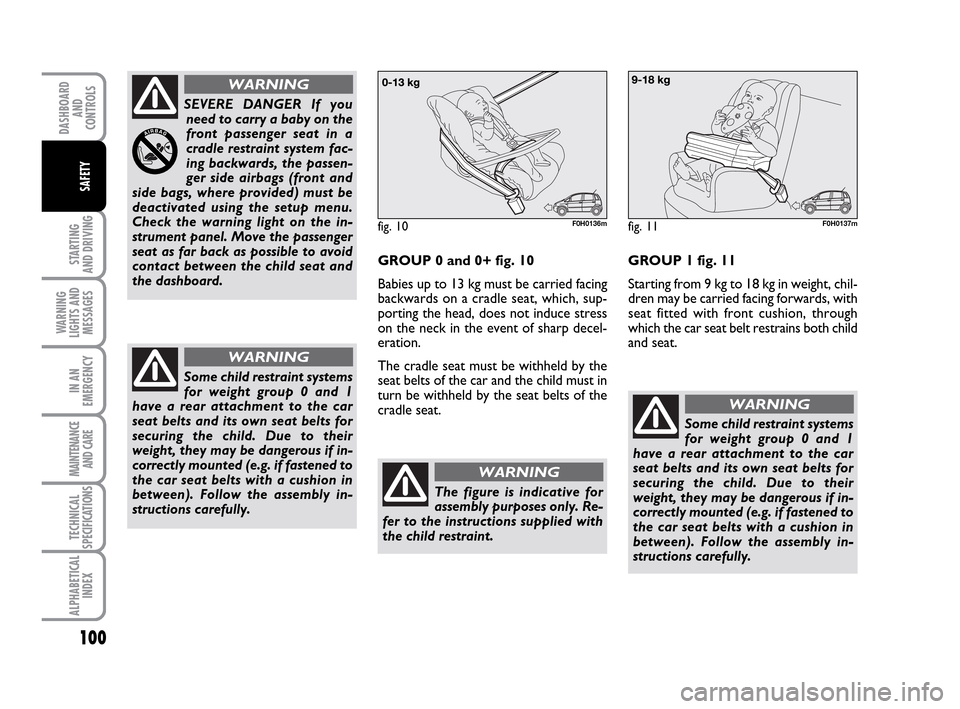
100
STARTING
AND DRIVING
WARNING
LIGHTS AND
MESSAGES
IN AN
EMERGENCY
MAINTENANCE
AND CARE
TECHNICAL
SPECIFICATIONS
ALPHABETICAL
INDEX
DASHBOARD
AND
CONTROLS
SAFETY
SEVERE DANGER If you
need to carry a baby on the
front passenger seat in a
cradle restraint system fac-
ing backwards, the passen-
ger side airbags (front and
side bags, where provided) must be
deactivated using the setup menu.
Check the warning light on the in-
strument panel. Move the passenger
seat as far back as possible to avoid
contact between the child seat and
the dashboard.
WARNING
GROUP 0 and 0+ fig. 10
Babies up to 13 kg must be carried facing
backwards on a cradle seat, which, sup-
porting the head, does not induce stress
on the neck in the event of sharp decel-
eration.
The cradle seat must be withheld by the
seat belts of the car and the child must in
turn be withheld by the seat belts of the
cradle seat.
fig. 10F0H0136m
The figure is indicative for
assembly purposes only. Re-
fer to the instructions supplied with
the child restraint.
WARNING
Some child restraint systems
for weight group 0 and 1
have a rear attachment to the car
seat belts and its own seat belts for
securing the child. Due to their
weight, they may be dangerous if in-
correctly mounted (e.g. if fastened to
the car seat belts with a cushion in
between). Follow the assembly in-
structions carefully.
WARNING
fig. 11F0H0137m
GROUP 1 fig. 11
Starting from 9 kg to 18 kg in weight, chil-
dren may be carried facing forwards, with
seat fitted with front cushion, through
which the car seat belt restrains both child
and seat.
Some child restraint systems
for weight group 0 and 1
have a rear attachment to the car
seat belts and its own seat belts for
securing the child. Due to their
weight, they may be dangerous if in-
correctly mounted (e.g. if fastened to
the car seat belts with a cushion in
between). Follow the assembly in-
structions carefully.
WARNING
093-110 LUM IDEA GB 2 ed.qxd 14-01-2010 12:16 Pagina 100
Page 102 of 210
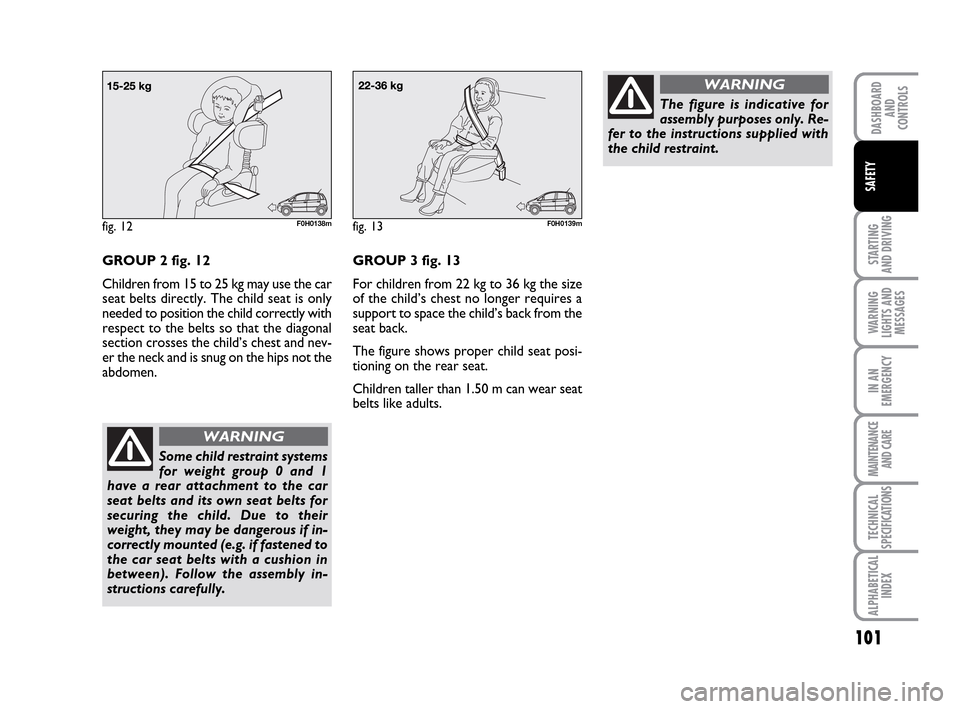
101
STARTING
AND DRIVING
WARNING
LIGHTS AND
MESSAGES
IN AN
EMERGENCY
MAINTENANCE
AND CARE
TECHNICAL
SPECIFICATIONS
ALPHABETICAL
INDEX
DASHBOARD
AND
CONTROLS
SAFETY
fig. 12F0H0138m
GROUP 2 fig. 12
Children from 15 to 25 kg may use the car
seat belts directly. The child seat is only
needed to position the child correctly with
respect to the belts so that the diagonal
section crosses the child’s chest and nev-
er the neck and is snug on the hips not the
abdomen.
Some child restraint systems
for weight group 0 and 1
have a rear attachment to the car
seat belts and its own seat belts for
securing the child. Due to their
weight, they may be dangerous if in-
correctly mounted (e.g. if fastened to
the car seat belts with a cushion in
between). Follow the assembly in-
structions carefully.
WARNING
fig. 13F0H0139m
The figure is indicative for
assembly purposes only. Re-
fer to the instructions supplied with
the child restraint.
WARNING
GROUP 3 fig. 13
For children from 22 kg to 36 kg the size
of the child’s chest no longer requires a
support to space the child’s back from the
seat back.
The figure shows proper child seat posi-
tioning on the rear seat.
Children taller than 1.50 m can wear seat
belts like adults.
093-110 LUM IDEA GB 2 ed.qxd 14-01-2010 12:16 Pagina 101
Page 103 of 210
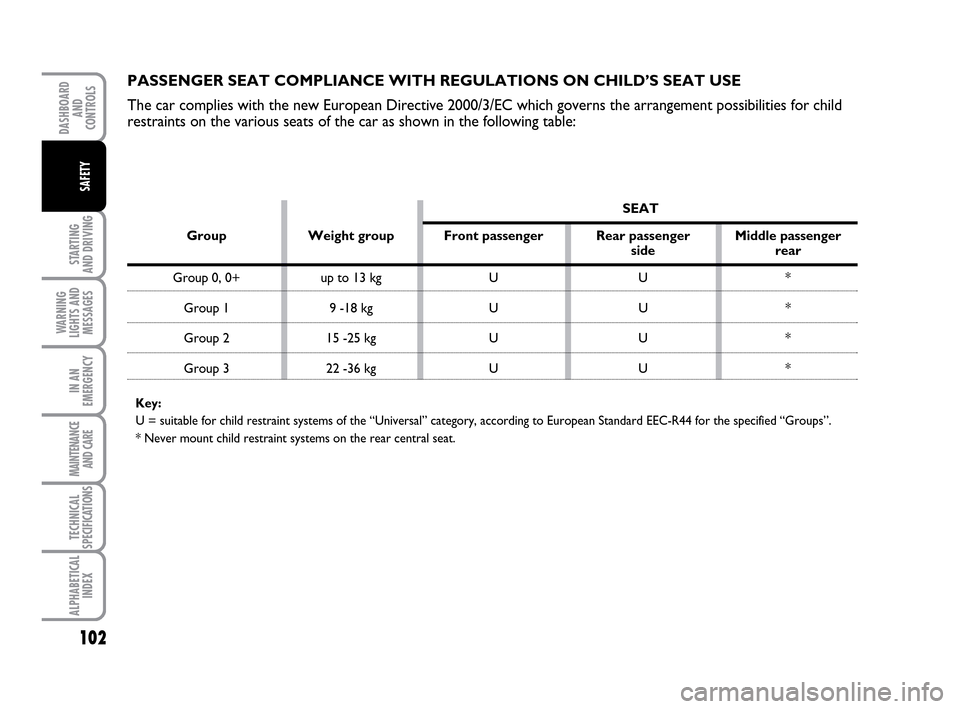
102
STARTING
AND DRIVING
WARNING
LIGHTS AND
MESSAGES
IN AN
EMERGENCY
MAINTENANCE
AND CARE
TECHNICAL
SPECIFICATIONS
ALPHABETICAL
INDEX
DASHBOARD
AND
CONTROLS
SAFETY
PASSENGER SEAT COMPLIANCE WITH REGULATIONS ON CHILD’S SEAT USE
The car complies with the new European Directive 2000/3/EC which governs the arrangement possibilities for child
restraints on the various seats of the car as shown in the following table:
SEAT
Group Weight group Front passenger Rear passenger Middle passenger
side rear
Group 0, 0+ up to 13 kg U U *
Group 1 9 -18 kg U U *
Group 2 15 -25 kg U U *
Group 3 22 -36 kg U U *
Key:
U = suitable for child restraint systems of the “Universal” category, according to European Standard EEC-R44 for the specified “Groups”.
* Never mount child restraint systems on the rear central seat.
093-110 LUM IDEA GB 2 ed.qxd 14-01-2010 12:16 Pagina 102
Page 104 of 210
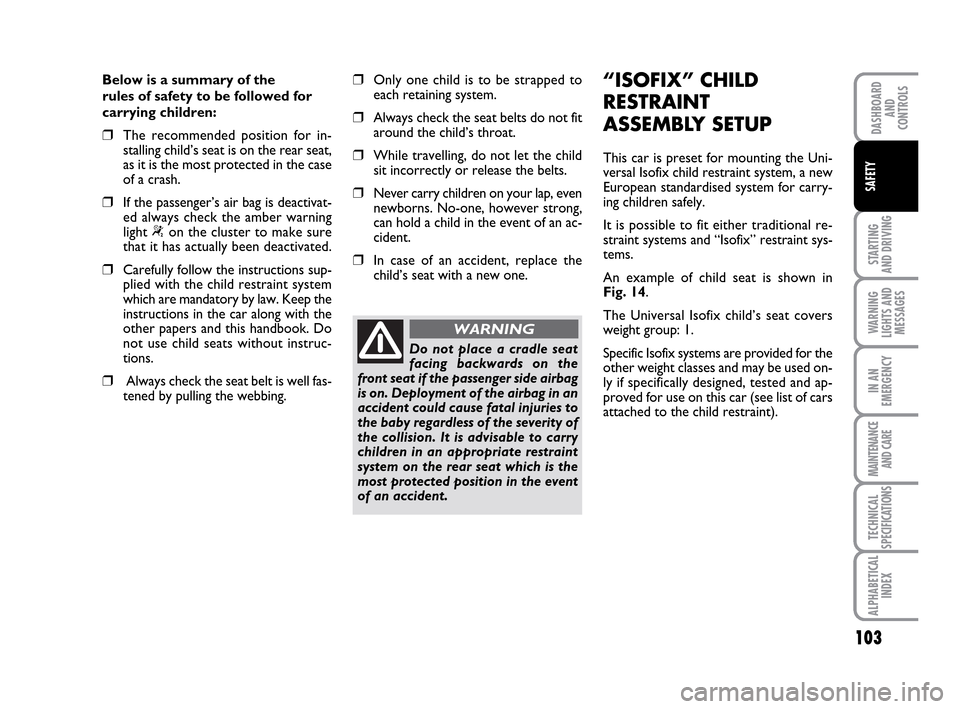
103
STARTING
AND DRIVING
WARNING
LIGHTS AND
MESSAGES
IN AN
EMERGENCY
MAINTENANCE
AND CARE
TECHNICAL
SPECIFICATIONS
ALPHABETICAL
INDEX
DASHBOARD
AND
CONTROLS
SAFETY
Below is a summary of the
rules of safety to be followed for
carrying children:
❒The recommended position for in-
stalling child’s seat is on the rear seat,
as it is the most protected in the case
of a crash.
❒If the passenger’s air bag is deactivat-
ed always check the amber warning
light “on the cluster to make sure
that it has actually been deactivated.
❒Carefully follow the instructions sup-
plied with the child restraint system
which are mandatory by law. Keep the
instructions in the car along with the
other papers and this handbook. Do
not use child seats without instruc-
tions.
❒Always check the seat belt is well fas-
tened by pulling the webbing.
❒Only one child is to be strapped to
each retaining system.
❒Always check the seat belts do not fit
around the child’s throat.
❒While travelling, do not let the child
sit incorrectly or release the belts.
❒Never carry children on your lap, even
newborns. No-one, however strong,
can hold a child in the event of an ac-
cident.
❒In case of an accident, replace the
child’s seat with a new one.
Do not place a cradle seat
facing backwards on the
front seat if the passenger side airbag
is on. Deployment of the airbag in an
accident could cause fatal injuries to
the baby regardless of the severity of
the collision. It is advisable to carry
children in an appropriate restraint
system on the rear seat which is the
most protected position in the event
of an accident.
WARNING
“ISOFIX” CHILD
RESTRAINT
ASSEMBLY SETUP
This car is preset for mounting the Uni-
versal Isofix child restraint system, a new
European standardised system for carry-
ing children safely.
It is possible to fit either traditional re-
straint systems and “Isofix” restraint sys-
tems.
An example of child seat is shown in
Fig. 14.
The Universal Isofix child’s seat covers
weight group: 1.
Specific Isofix systems are provided for the
other weight classes and may be used on-
ly if specifically designed, tested and ap-
proved for use on this car (see list of cars
attached to the child restraint).
093-110 LUM IDEA GB 2 ed.qxd 14-01-2010 12:16 Pagina 103
Page 105 of 210

104
STARTING
AND DRIVING
WARNING
LIGHTS AND
MESSAGES
IN AN
EMERGENCY
MAINTENANCE
AND CARE
TECHNICAL
SPECIFICATIONS
ALPHABETICAL
INDEX
DASHBOARD
AND
CONTROLS
SAFETY
fig. 15F0H0140m
Fit the child seat when the
car is stationary. The child
seat is correctly anchored to the
brackets when you hear the click. Fol-
low the instructions for assembly, dis-
assembly and positioning that the
manufacturer must supply with the
child seat.
WARNING
fig. 14F0H0019m
Due to its different anchoring system, an
Isofix child restraint must be anchored to
the proper lower metal rings A-fig. 15,
between rear seat back and cushion. The
upper belt (provided with the child re-
strain) must be then secured to ring D-
fig. 16set in the boot at child’s seat lev-
el.
fig. 16F0H0143m
Remember that in case of Universal Isofix
child restrain systems, you can only use all
those seats approved with the marking
ECE R44/03 “Universal Isofix”.
Universal Isofix “Duo Plus” child seat is
available from Lineaccessori Fiat.
For any further details on installation/use,
refer to the “Instruction Manual” for the
child seat.
093-110 LUM IDEA GB 2 ed.qxd 14-01-2010 12:16 Pagina 104
Page 106 of 210
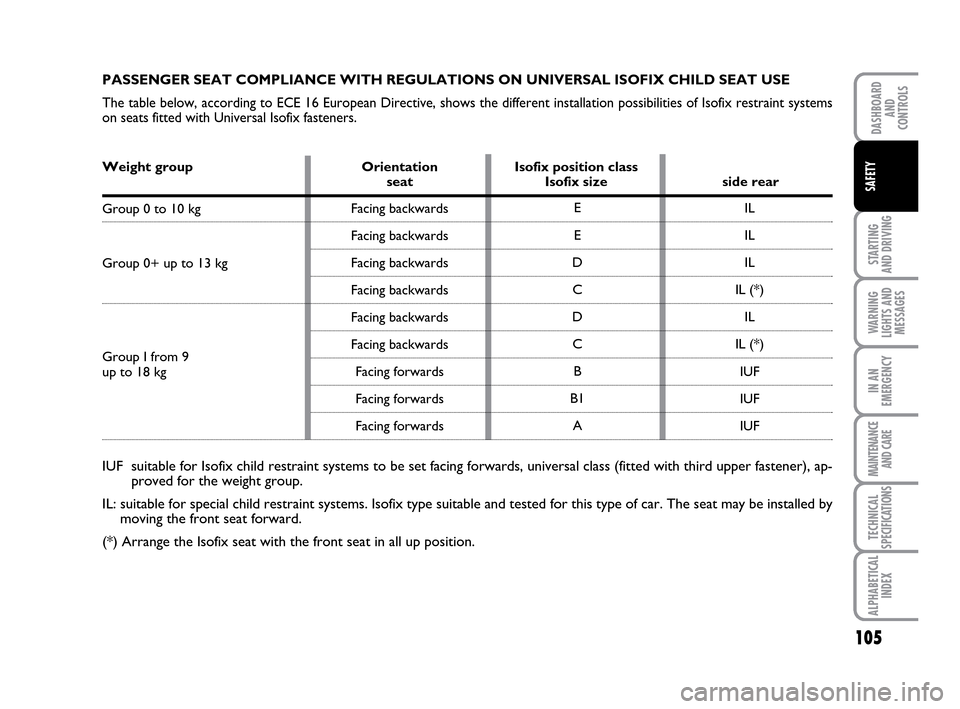
105
STARTING
AND DRIVING
WARNING
LIGHTS AND
MESSAGES
IN AN
EMERGENCY
MAINTENANCE
AND CARE
TECHNICAL
SPECIFICATIONS
ALPHABETICAL
INDEX
DASHBOARD
AND
CONTROLS
SAFETY
PASSENGER SEAT COMPLIANCE WITH REGULATIONS ON UNIVERSAL ISOFIX CHILD SEAT USE
The table below, according to ECE 16 European Directive, shows the different installation possibilities of Isofix restraint systems
on seats fitted with Universal Isofix fasteners.
Weight group Orientation Isofix position class seat Isofix size side rear
Group 0 to 10 kg
Group 0+ up to 13 kg
Group I from 9
up to 18 kg
Facing backwards
Facing backwards
Facing backwards
Facing backwards
Facing backwards
Facing backwards
Facing forwards
Facing forwards
Facing forwardsE
E
D
C
D
C
B
B1
AIL
IL
IL
IL (*)
IL
IL (*)
IUF
IUF
IUF
IUF suitable for Isofix child restraint systems to be set facing forwards, universal class (fitted with third upper fastener), ap-
proved for the weight group.
IL: suitable for special child restraint systems. Isofix type suitable and tested for this type of car. The seat may be installed by
moving the front seat forward.
(*) Arrange the Isofix seat with the front seat in all up position.
093-110 LUM IDEA GB 2 ed.qxd 14-01-2010 12:16 Pagina 105
Page 107 of 210
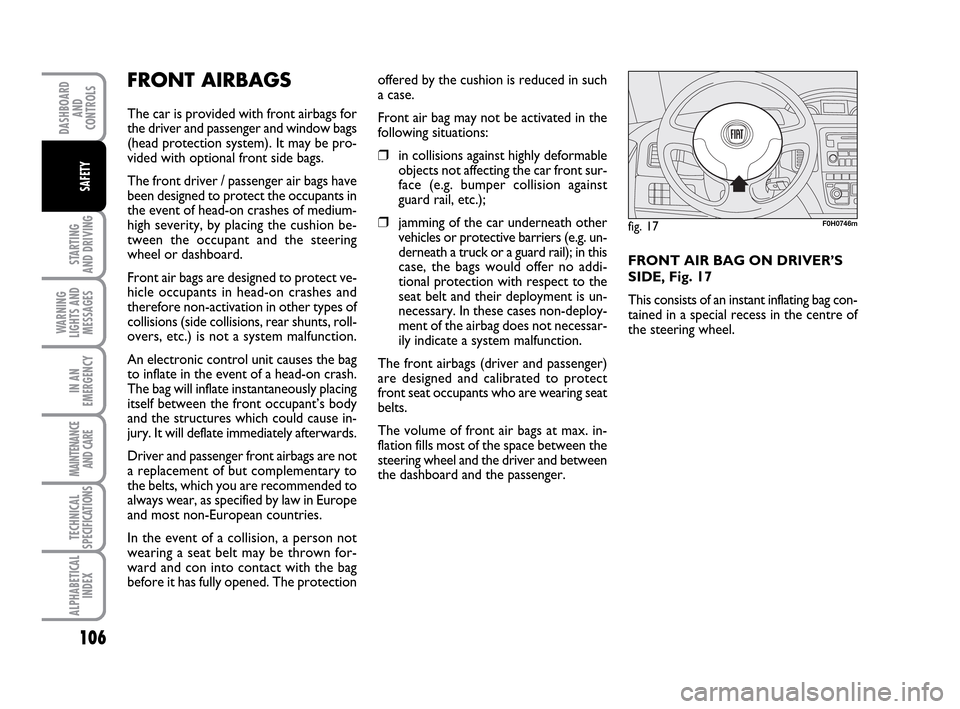
106
STARTING
AND DRIVING
WARNING
LIGHTS AND
MESSAGES
IN AN
EMERGENCY
MAINTENANCE
AND CARE
TECHNICAL
SPECIFICATIONS
ALPHABETICAL
INDEX
DASHBOARD
AND
CONTROLS
SAFETY
FRONT AIRBAGS
The car is provided with front airbags for
the driver and passenger and window bags
(head protection system). It may be pro-
vided with optional front side bags.
The front driver / passenger air bags have
been designed to protect the occupants in
the event of head-on crashes of medium-
high severity, by placing the cushion be-
tween the occupant and the steering
wheel or dashboard.
Front air bags are designed to protect ve-
hicle occupants in head-on crashes and
therefore non-activation in other types of
collisions (side collisions, rear shunts, roll-
overs, etc.) is not a system malfunction.
An electronic control unit causes the bag
to inflate in the event of a head-on crash.
The bag will inflate instantaneously placing
itself between the front occupant’s body
and the structures which could cause in-
jury. It will deflate immediately afterwards.
Driver and passenger front airbags are not
a replacement of but complementary to
the belts, which you are recommended to
always wear, as specified by law in Europe
and most non-European countries.
In the event of a collision, a person not
wearing a seat belt may be thrown for-
ward and con into contact with the bag
before it has fully opened. The protectionoffered by the cushion is reduced in such
a case.
Front air bag may not be activated in the
following situations:
❒in collisions against highly deformable
objects not affecting the car front sur-
face (e.g. bumper collision against
guard rail, etc.);
❒jamming of the car underneath other
vehicles or protective barriers (e.g. un-
derneath a truck or a guard rail); in this
case, the bags would offer no addi-
tional protection with respect to the
seat belt and their deployment is un-
necessary. In these cases non-deploy-
ment of the airbag does not necessar-
ily indicate a system malfunction.
The front airbags (driver and passenger)
are designed and calibrated to protect
front seat occupants who are wearing seat
belts.
The volume of front air bags at max. in-
flation fills most of the space between the
steering wheel and the driver and between
the dashboard and the passenger.FRONT AIR BAG ON DRIVER’S
SIDE, Fig. 17
This consists of an instant inflating bag con-
tained in a special recess in the centre of
the steering wheel.fig. 17F0H0746m
093-110 LUM IDEA GB 2 ed.qxd 14-01-2010 12:16 Pagina 106
Page 108 of 210
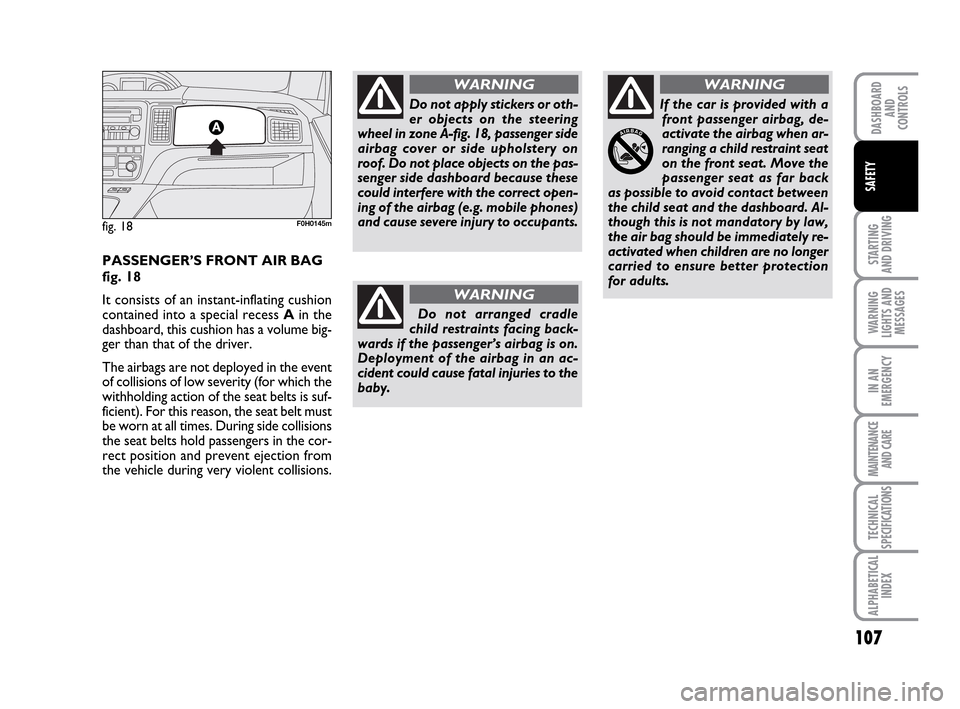
107
STARTING
AND DRIVING
WARNING
LIGHTS AND
MESSAGES
IN AN
EMERGENCY
MAINTENANCE
AND CARE
TECHNICAL
SPECIFICATIONS
ALPHABETICAL
INDEX
DASHBOARD
AND
CONTROLS
SAFETY
fig. 18F0H0145m
PASSENGER’S FRONT AIR BAG
fig. 18
It consists of an instant-inflating cushion
contained into a special recess Ain the
dashboard, this cushion has a volume big-
ger than that of the driver.
The airbags are not deployed in the event
of collisions of low severity (for which the
withholding action of the seat belts is suf-
ficient). For this reason, the seat belt must
be worn at all times. During side collisions
the seat belts hold passengers in the cor-
rect position and prevent ejection from
the vehicle during very violent collisions.
Do not apply stickers or oth-
er objects on the steering
wheel in zone A-fig. 18, passenger side
airbag cover or side upholstery on
roof. Do not place objects on the pas-
senger side dashboard because these
could interfere with the correct open-
ing of the airbag (e.g. mobile phones)
and cause severe injury to occupants.
WARNING
Do not arranged cradle
child restraints facing back-
wards if the passenger’s airbag is on.
Deployment of the airbag in an ac-
cident could cause fatal injuries to the
baby.
WARNING
If the car is provided with a
front passenger airbag, de-
activate the airbag when ar-
ranging a child restraint seat
on the front seat. Move the
passenger seat as far back
as possible to avoid contact between
the child seat and the dashboard. Al-
though this is not mandatory by law,
the air bag should be immediately re-
activated when children are no longer
carried to ensure better protection
for adults.
WARNING
093-110 LUM IDEA GB 2 ed.qxd 14-01-2010 12:16 Pagina 107
Page 109 of 210
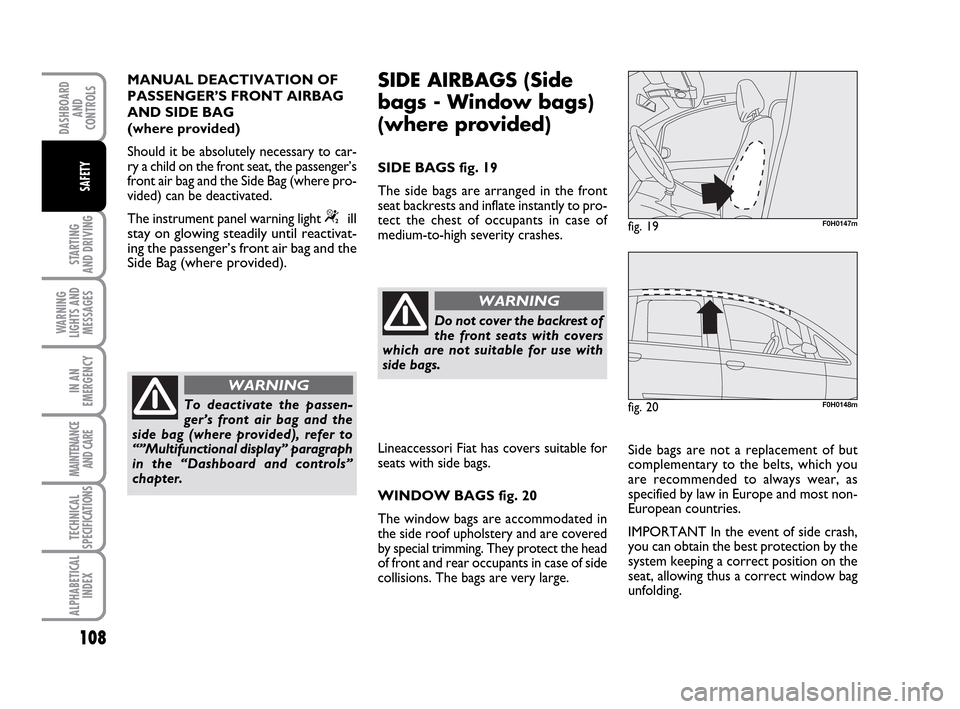
108
STARTING
AND DRIVING
WARNING
LIGHTS AND
MESSAGES
IN AN
EMERGENCY
MAINTENANCE
AND CARE
TECHNICAL
SPECIFICATIONS
ALPHABETICAL
INDEX
DASHBOARD
AND
CONTROLS
SAFETY
To deactivate the passen-
ger’s front air bag and the
side bag (where provided), refer to
“”Multifunctional display” paragraph
in the “Dashboard and controls”
chapter.
WARNING
MANUAL DEACTIVATION OF
PASSENGER’S FRONT AIRBAG
AND SIDE BAG
(where provided)
Should it be absolutely necessary to car-
ry a child on the front seat, the passenger’s
front air bag and the Side Bag (where pro-
vided) can be deactivated.
The instrument panel warning light
“ill
stay on glowing steadily until reactivat-
ing the passenger’s front air bag and the
Side Bag (where provided).
SIDE AIRBAGS (Side
bags - Window bags)
(where provided)
SIDE BAGS fig. 19
The side bags are arranged in the front
seat backrests and inflate instantly to pro-
tect the chest of occupants in case of
medium-to-high severity crashes.
Side bags are not a replacement of but
complementary to the belts, which you
are recommended to always wear, as
specified by law in Europe and most non-
European countries.
IMPORTANT In the event of side crash,
you can obtain the best protection by the
system keeping a correct position on the
seat, allowing thus a correct window bag
unfolding.
Do not cover the backrest of
the front seats with covers
which are not suitable for use with
side bags.
WARNING
Lineaccessori Fiat has covers suitable for
seats with side bags.
WINDOW BAGS fig. 20
The window bags are accommodated in
the side roof upholstery and are covered
by special trimming. They protect the head
of front and rear occupants in case of side
collisions. The bags are very large.
fig. 19F0H0147m
fig. 20F0H0148m
093-110 LUM IDEA GB 2 ed.qxd 14-01-2010 12:16 Pagina 108
Page 110 of 210

109
STARTING
AND DRIVING
WARNING
LIGHTS AND
MESSAGES
IN AN
EMERGENCY
MAINTENANCE
AND CARE
TECHNICAL
SPECIFICATIONS
ALPHABETICAL
INDEX
DASHBOARD
AND
CONTROLS
SAFETY
IMPORTANT The front air bags and/or
side bags may be deployed if the car is sub-
ject to heavy knocks or accidents involv-
ing the underbody area, such as for ex-
ample violent shocks, against steps, kerbs
or low obstacles, falling of the car in big
holes or sags in the road.
IMPORTANT A small amount of dust will
be released when the airbags are de-
ployed. The dust is not harmful and does
not indicate the beginning of a fire. Fur-
thermore, the surface of the deployed bag
and the interior of the car may be covered
in a dusty residue: This dust may irritate
the skin and the eyes. Wash with mild
soap and water in the event of exposure.
The airbag system expires after 14 years
(charge) and 10 years (clock contact). Go
to a Fiat Dealership to have the devices
replaced when the expiration date ap-
proaches.
IMPORTANT Should an accident occur in
which any of the safety devices is activat-
ed, take the car to a Fiat Dealership to
have the devices activated replaced and to
have the system checked.
Every control, repair and replacement op-
erations concerning the air bags must on-
ly be carried out c/o Fiat Dealership.If you are having the car scrapped, have
the air bag system deactivated at a Fiat
Dealership first. If the car changes own-
ership, the new owner must be informed
of the method of use of air bags and the
above warnings and also be given this
“Owner‘s Handbook”.
IMPORTANT Pretensioners, front airbags
and front side bags are deployed differ-
ently according to the type of collision.
Non deployment of one of the devices
does not therefore indicate a system fault.
Do not rest your head, arms
or elbows on the door, on
the windows and in the window bag
area to prevent injury in case of de-
ployment.
WARNING
Never lean head, arms and
elbows out of window.
WARNING
If when turning the key to
MAR the warning light
¬does not turn on or stays on whilst
driving (together with the message in
the multifunctional display, where
provided), a failure may have oc-
curred in the restraint systems. In this
case the air bags or pretensioners
may not be deployed after an impact
or, in a minor number of cases, they
may be deployed accidentally. Con-
tact a Fiat Dealership immediately to
have the system checked.
WARNING
GENERAL WARNINGS
Do not cover the backrest of
the front seats with covers
which are not suitable for use with
side bags.
WARNING
Always drive holding your
hands on the steering wheel
rim so that the airbag can inflate
freely in the case of need. Do not dri-
ve with your body bent forward. Keep
your back straight against the back
rest.
WARNING
093-110 LUM IDEA GB 2 ed.qxd 14-01-2010 12:16 Pagina 109